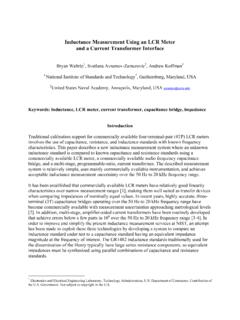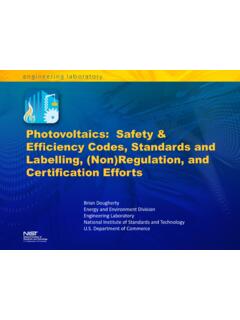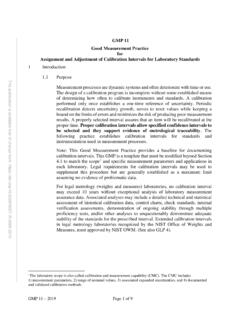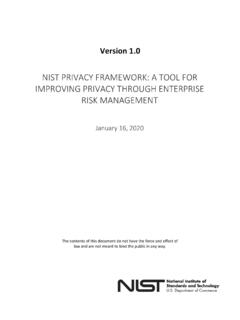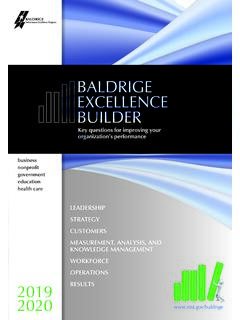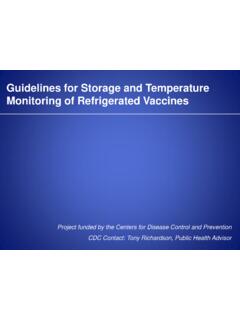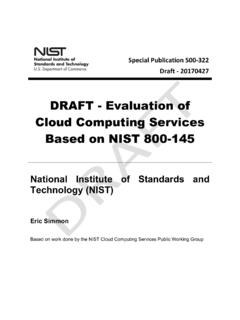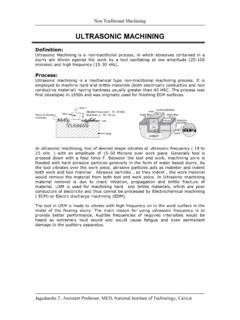Transcription of Operator’s Manual - NIST
1 CPN-214-142. Rev. A. ultrasonic Cleaners Models 1510, 2510, 3510, 5510, 8510. Operator's Manual Warranty ultrasonic Cleaners, when used in accordance with manufacturer's instructions and under normal use, are guaranteed for two years after date of shipment. Within the period guaranteed, manufacturer will repair or replace free of charge, at its sole discretion, all parts that are defective because of material or workmanship, not including costs for removing or installing parts. Liability, whether based on warranty, negligence or other cause, arising out of and/or incidental to sale, use or operation of the transducer elements, or any part thereof, shall not in any case exceed the cost of repair or replacement of the defective equipment, and such repair or replacement shall be the exclusive remedy of the purchaser, and in no case will we be responsible for any and/or all consequential or incidental damages including without limitation, and/or all consequential damages arising out of commercial losses.
2 CAUTION. Do not place parts or containers directly on the bottom of the cleaning tank; use a tray or wire to suspend items. Do not allow the solution to drop more than 3/8 inch below the operating level line with the cleaner on. Do not ever use alcohol, gasoline or flammable solutions. Doing so could cause a fire or explosion. Use only water-based solutions. Do not use mineral acids. These could damage the tank. Contents Front WARRANTY. Cover 1 Safety Precautions 3 Introduction 3 ultrasonic Cleaners 4 Accessories 4 Unpacking Your Cleaner 4 Installing Your Cleaner 5 Equipment Specifications 6 How ultrasonic Cleaning Works 7 Operating Your Cleaner 7 Operating Your MT or MTH Cleaner 10 Operating Your DTH Cleaner 14 Draining Your Cleaner 16 Optimizing Your Cleaner 18 Application Hints 19 Cleaning Methods 21 Cleaning Solutions 24 Troubleshooting 28 Service Information Safety Precautions Before using your ultrasonic Cleaner, please read and thoroughly understand these safety precautions.
3 Failure to follow them may result in serious personal injury or property damage. To avoid electrical shock: Do unplug from power source before filling or emptying the tank. Do keep the control panel and the area around the cleaner clean and dry -- wipe up solution which spills over the tank brim. Water and high voltage can cause electrical shock. Do not operate the cleaner without proper grounding. Do not remove the grounding prong on the line cord plug. Do not disassemble your cleaner -- high voltage inside the cleaner is dangerous. Do not immerse the cleaner in water. To prevent personal and/or property damage: Do operate the cleaner with a vented cover or no cover. Do use water-based solutions. Do not ever use alcohol, gasoline or flammable solutions.
4 Doing so could cause a fire or explosion and will void your warranty. Use only water-based solutions. Do not ever use mineral acids. These could damage the tank. Do not touch the stainless steel tank or cleaning solution -- they may be hot. Do not allow fluid temperature to exceed 70 C (160 F). Do not place your fingers or hands into the tank while the cleaner is operating. Doing so may cause discomfort and possible skin irritation. Avoid contact with solutions and provide adequate ventilation. Do not use solutions containing chlorine bleach. 1 Safety Precautions To prevent damage to the cleaner: Do change your solution regularly. Do not cover vents on the cover. Do not operate the cleaner dry. Do not place parts or containers directly on the bottom of the cleaning tank; use a tray or wire to suspend items.
5 Failure to comply may cause transducer damage and will void your warranty. Do not allow the solution to drop more than 3/8 inch below the operating level line with heat or ultrasonics on. Failure to comply may cause transducer and/or heater damage and will void your warranty. 2 Safety Precautions Introduction ultrasonic Cleaners This line of ultrasonic cleaners include five models with sizes ranging from 1/2 gallons, 3/4 gallons, 1-1/2 gallons, 2-1/2 gallons and 5-1/2. gallons. Each model is constructed using durable industrial style 40kHz transducers. These provide increased cleaning power along with built in sweep frequency to ensure uniform cleaning activity throughout the bath. The 1/2 and 3/4 gallon models have a molded dip in their rims to facilitate emptying of solution from the tank.
6 The three larger sizes have built in drains and are supplied with tank drain kits. Each model can be purchased in three different configurations -- with a Mechanical Timer (MT), with a Mechanical Timer plus Heat (MTH) and with Digital Control, plus Heat and Timer (DTH). When you first fill your unit, or refill it with fresh solution, use warm water for the solution. Turn on the heater (press the HEAT switch, if available), turn on the ultrasonics (press SONICS or rotate the Timer knob), add the cover and the solution will heat quickly to temperature. 3 Introduction Accessories For Your Cleaner Accessories include regular and beaker positioning covers, solid and perforated insert trays, mesh baskets and beakers. Unpacking Your Cleaner Please check your cleaner and its carton carefully for any external or internal damage.
7 If you find damage, contact your shipping carrier immediately, before contacting your distributor. Please retain your packaging for future use. Installing Your Cleaner Check the plate on the back of the cleaner for correct power requirements. Position your cleaner within easy reach of a standard grounded electrical outlet. Do not place the cleaner on a circuit which could become overloaded. If your cleaner does not operate correctly, first refer to the troubleshooting section for possible causes, or contact an authorized service center listed at the back of this Manual , for additional information. 4 Introduction Equipment Specifications Tank Tank Overall Weight Max Heater Max. Capacity Size Size Input Power Draw Power Power Req. (Watts)*. 1/2 gal.
8 L: 6 L: 10 7 lbs. 80W 0 80. ( L) W: W: 12 ( ) 63 143. D: 4 D: 63 143. 3/4 gal. L: L: 9 lbs. 130W 0 130. ( L) W: W: 12 (4. KG) 109 239. D: 4 D: 109 239. 1-1/2 gal. L: L: 16 12 lbs. 130W 0 130. ( L) W: 6 W: 12 ( KG) 205 335. D: 6 D: 205 335. 2-1/2 gal. L: L: 16 14 lbs. 185W 0 185. ( L) W: W: ( KG) 284 469. D: 6 D: 284 469. 5-1/2 gal. L: L: 24 26 lbs. 320W 0 320. ( L) W: 18 ( KG) 561 881. D: 6 D: 561 881. NOTE: All models have a frequency of 40kHz. In DTH cleaners, the temperature readout accuracy is 4 C. 120V 10%, 60Hz is optimum voltage for all cleaners. All cleaners have CSA approval and comply with FCC regulations. All 220V units meet CE standards. * indicates power levels for MT, MTH and DTH cleaners, in that order. Units will cause GFI sockets to trip.
9 All units have a ground leakage current less than .50ma. 5 Introduction How Ultrasonics Cleaning Works ultrasonic sound is sound transmitted at frequencies generally beyond the range of human hearing. In your ultrasonic cleaner, ultrasonic sound (sonics) is used for cleaning materials and parts. This is how it works: As the sound waves from the transducer radiate through the solution in the tank, they cause alternating high and low pressures in the solution. During the low pressure stage, millions of microscopic bubbles form and grow. This process is called CAVITATION, meaning formation of cavities . During the high pressure stage, the bubbles collapse, or implode . releasing enormous amounts of energy. These implosions act like an army of tiny scrub brushes.
10 They work in all directions, attack- ing every surface and invading all recesses and openings. 6 Introduction Operating Your Cleaner If this is the first time you are using the cleaner, please read this whole section before operating your cleaner. Operating Your MT or MTH Cleaner MT Cleaner MTH Cleaner Explanation of Controls Control Function HEAT Activates heat to 60 C maximum. (MTH only) NOTE: Refer to pages 16 and 17 for further temperature information. TIMER Activates ultrasonics and sets time. Use to turn unit Off. Turn clockwise for variable time 0-60 mins. Turn counterclockwise to hold position for continuous operation. 7 Operating Your Cleaner Before You Start Cleaning CAUTION. Do not place parts or containers directly on the bottom of the cleaning tanks; use a tray or wire to suspend items.
